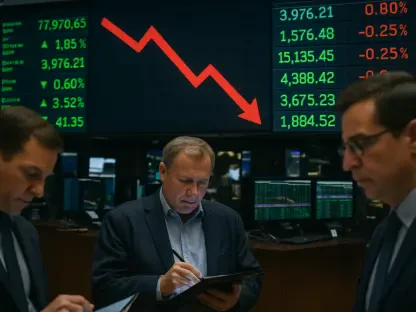In today’s ever-shifting financial landscape, global flexible bond funds have carved out a significant niche for investors looking to balance risk and reward in the fixed income arena. These funds are uniquely positioned to adapt to varying market conditions by leveraging active management, allowing them to pivot across diverse bond sectors such as government securities, corporate debt, and emerging market assets. Unlike more rigid investment vehicles, their ability to pursue absolute returns—independent of traditional benchmarks—offers a tantalizing prospect for those seeking consistent gains in unpredictable times. However, with this flexibility comes complexity, as rapid shifts in risk profiles and higher costs challenge even seasoned investors. This exploration delves into the core advantages of these funds, unpacks the inherent risks, and highlights three standout options as rated by Morningstar’s esteemed research team, providing a roadmap for navigating this dynamic segment of the bond market.
Unpacking the Appeal of Flexible Bond Strategies
Global flexible bond funds are engineered for adaptability, setting them apart from conventional bond investments that often adhere strictly to predefined benchmarks. Their absolute-return orientation empowers fund managers to chase positive outcomes regardless of broader market trends, allocating capital to areas showing the most promise—whether that’s high-yield corporate bonds or government debt from emerging economies. This nimbleness can serve as a powerful buffer against volatility, enabling these funds to weather economic storms that might derail more constrained strategies. Yet, this very freedom introduces a layer of uncertainty, as the risk profile of a fund can shift dramatically with each tactical move. Investors must remain alert to how these changes might impact a diversified portfolio, ensuring alignment with long-term financial goals while embracing the potential for outsized returns in favorable conditions.
Beyond their strategic agility, these funds often capitalize on the inefficiencies inherent in the bond market, a space where pricing discrepancies and diverse instruments create fertile ground for skilled managers. Unlike equity markets, where passive index funds frequently dominate due to lower costs and simplicity, the fixed income realm rewards deep research and quick adjustments. This environment allows global flexible bond funds to target undervalued securities or sidestep looming risks like credit defaults, offering a distinct edge over static approaches. However, this advantage hinges on the quality of the management team, as the breadth of investment choices—from traditional bonds to complex derivatives—demands expertise across multiple subsectors. For those considering this path, understanding the fund’s approach to market navigation becomes as critical as evaluating its past performance.
Active Management as a Competitive Advantage
The strength of active management in global flexible bond funds cannot be overstated, particularly in a market rife with inconsistencies and complexities that passive strategies struggle to address. Bond markets differ markedly from equities, where low-cost index tracking often suffices due to greater transparency and efficiency. In contrast, fixed income spaces are characterized by fragmented pricing and a vast array of instruments, creating opportunities for astute managers to unearth mispriced assets or avoid potential downgrades. This hands-on approach, rooted in meticulous bottom-up analysis, enables funds to generate returns that can outpace benchmarks, justifying their place in an investor’s toolkit. The ability to pivot swiftly in response to economic signals further enhances their appeal, especially in turbulent periods when passive funds may falter under rigid constraints.
Moreover, active management in this context thrives on the capacity to tailor risk exposure dynamically, a critical factor given the diverse nature of bond investments. Managers of global flexible bond funds often employ sophisticated tools, including derivatives like credit default swaps, to hedge against downturns or amplify gains in specific sectors. This strategic depth allows for a more nuanced response to interest rate shifts or geopolitical events, which can disproportionately impact fixed income assets compared to stocks. However, such complexity requires robust oversight and a seasoned team capable of balancing innovation with caution. Investors should prioritize funds with a demonstrated history of navigating full market cycles, as this track record often signals the resilience needed to deliver consistent value over time, even when market conditions turn adverse.
Balancing Risks and Financial Considerations
While the potential for strong performance in global flexible bond funds is undeniable, the associated risks demand careful scrutiny before committing capital. The wide latitude granted to managers means portfolios can shift rapidly between conservative government bonds and riskier high-yield or emerging market debt, altering the fund’s risk profile almost overnight. Additionally, the frequent use of derivatives to manage exposure or express market views introduces another layer of complexity, as missteps in these instruments can amplify losses during volatile periods. Strong risk management systems are essential to monitor and stress-test holdings, ensuring that funds can endure market shocks without derailing investor objectives. Only teams with deep expertise across bond categories can effectively steer through these challenges, making manager selection a pivotal decision.
Cost considerations also play a significant role in evaluating these funds, as fees in the global flexible bond category often exceed those of other fixed income options. With average annual charges notably higher than for diversified or passive bond trackers, the question arises whether the potential for alpha—returns above a benchmark—justifies the expense. Investors must assess if a fund’s historical outperformance aligns with its cost structure, as cheaper alternatives may suffice for those with lower risk appetites or simpler goals. This financial balancing act underscores the importance of transparency in fee reporting and a clear understanding of how active management adds value. Diligent comparison of expense ratios against performance metrics can guide decisions, ensuring that the premium paid for flexibility translates into tangible benefits over the investment horizon.
Highlighting Elite Performers in the Category
Morningstar’s rigorous analysis has identified three exemplary global flexible bond funds that embody the best practices of this investment class, each earning high marks for their management and processes. The BGF Fixed Income Global Opportunities fund, with a Gold rating, stands out under the leadership of veteran manager Rick Rieder, leveraging an extensive research framework supported by a large team of fixed income specialists. Its approach spans a wide array of assets, from traditional bonds to emerging market debt, while maintaining a disciplined risk profile through small, consistent gains rather than high-stakes bets. This balance of breadth and caution positions it as a reliable choice for those seeking steady returns across diverse market environments, demonstrating how comprehensive resources can translate into superior outcomes.
Equally impressive is the Dodge & Cox Worldwide Global Bond fund, also Gold-rated, which adopts a patient, concentrated strategy managed by a seasoned committee with decades of collective experience. With a portfolio typically comprising 50-80 issuers and a focus on corporate debt alongside diversified allocations, it prioritizes lower turnover to minimize transaction costs while capping non-US currency exposure for added stability. Its competitive fee structure further enhances its attractiveness, offering value alongside a strong long-term track record. Meanwhile, the Pimco GIS Diversified Income fund, rated Silver, brings a credit-heavy focus, drawing on the expertise of a skilled team to build exposure across developed and emerging markets. Its willingness to allocate significantly to out-of-benchmark assets like mortgage-backed securities sets it apart, catering to investors comfortable with a bolder stance on global opportunities.
Key Factors for Informed Investment Choices
Selecting the right global flexible bond fund requires a keen focus on the expertise and track record of the management team, given the intricate nature of the strategies involved. Funds that excel often boast professionals with extensive knowledge across bond subsectors, from government securities to high-yield corporates, ensuring they can capitalize on opportunities wherever they arise. A proven history of navigating various market conditions—through booms and busts alike—serves as a strong indicator of a team’s ability to adapt without succumbing to undue risk. As the use of derivatives becomes more prevalent in these funds to manage volatility or enhance returns, robust risk controls become non-negotiable, safeguarding against potential pitfalls that could erode gains in unexpected downturns.
Equally important is aligning a fund’s approach with individual investment goals, as the flexibility that defines this category can be both a strength and a challenge. Investors should evaluate how a fund’s dynamic allocations might complement or conflict with existing holdings, ensuring a cohesive portfolio strategy. Examining the balance between potential returns and associated costs remains critical, as higher fees must be matched by commensurate performance to warrant inclusion. By studying funds like those spotlighted by Morningstar, which exemplify disciplined processes and seasoned leadership, a clearer path emerges for capitalizing on the unique advantages of global flexible bond funds. This deliberate approach helps mitigate the inherent complexities, positioning investors to harness the full potential of active management in the fixed income space.









